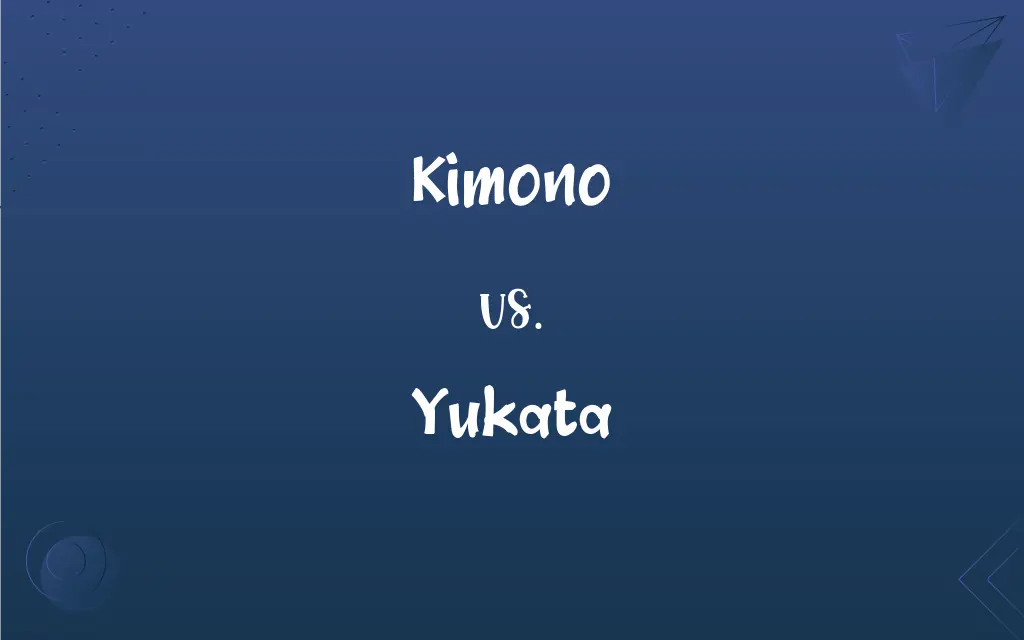Kimono vs. Yukata: What's the Difference?
Edited by Aimie Carlson || By Janet White || Published on March 21, 2024
Kimono is a traditional Japanese garment with multiple layers, worn for formal occasions. Yukata is a lighter, cotton version worn in summer and for casual events.

Key Differences
The kimono and yukata are traditional Japanese garments recognized for their beauty, style, and cultural significance, but they serve different purposes and are worn in distinct contexts. A kimono is a formal garment made from silk and is often worn for important festivals, ceremonies, or weddings. In contrast, a yukata is a more casual and lighter garment, typically made from cotton or synthetic fabric, making it ideal for the summer months. Yukatas are commonly worn at festivals, fireworks, and other casual events. They are easier to wear and more comfortable than kimonos, often seen as a more relaxed and accessible option for people who want to participate in traditional Japanese culture without the formality and complexity of a kimono.
The kimono's history dates back hundreds of years, serving as a symbol of Japanese tradition and elegance. The complexity of wearing a kimono, including the art of choosing the appropriate type for a specific occasion, reflects deep cultural traditions and the Japanese aesthetic. Yukatas, meanwhile, originated as bathrobes worn in traditional Japanese inns (ryokan) but have evolved into popular summer festival attire. The ease of wearing a yukata, combined with its breathability and lightweight fabric, has made it a favorite among both Japanese people and visitors.
Both garments embody the beauty of Japanese culture and tradition, the kimono represents formality and elegance, whereas the yukata offers a more casual, accessible way to enjoy traditional Japanese attire. The choice between wearing a kimono or a yukata often depends on the event, the season, and personal preference, with each garment providing a unique way to experience and participate in Japanese cultural practices.
Comparison Chart
Material
Silk, sometimes wool or synthetic
Cotton or synthetic fabric
Occasion
Formal events, ceremonies
Casual summer events, festivals
ADVERTISEMENT
Layers
Multiple, depending on season
Single layer, lighter
Wearability
Complex, often requires assistance
Easier to wear, more user-friendly
Design
Elaborate, with significant symbolism
Simpler, more casual patterns
Kimono and Yukata Definitions
Kimono
They are worn with an obi belt.
The obi belt added elegance to her kimono ensemble.
Yukata
Yukatas are popular at festivals and casual events.
Everyone wore yukatas to the fireworks display.
ADVERTISEMENT
Kimono
A traditional Japanese garment worn for formal occasions.
She wore a beautiful silk kimono to the tea ceremony.
Yukata
A casual cotton kimono worn in the summer.
I bought a colorful yukata for the summer festival.
Kimono
It's made from luxurious fabrics like silk.
The silk kimono shimmered with intricate embroidery.
Yukata
It's lighter and more comfortable than a kimono.
The cotton yukata was perfect for the hot summer evening.
Kimono
Kimonos reflect the wearer's status and occasion.
His formal kimono was adorned with family crests for the wedding.
Yukata
Yukatas offer a relaxed way to enjoy Japanese traditions.
Wearing a yukata made the festival experience feel authentic.
Kimono
Kimonos have deep cultural and historical significance.
The museum's kimono exhibit showcased centuries of Japanese tradition.
Yukata
They are accessorized with a simpler obi.
She tied her yukata with a bright, woven obi.
Kimono
A long, wide-sleeved Japanese robe worn with an obi and often elaborately decorated.
Yukata
A lightweight informal kimono, usually made of cotton.
Yukata
A kind of light kimono worn by both men and women.
FAQs
When should you wear a kimono?
For formal events, ceremonies, or traditional festivals.
Is it easy to put on a yukata?
Yes, it's much simpler than wearing a kimono and can be done without assistance.
What's the main difference between a kimono and a yukata?
Kimonos are formal and made from silk, while yukatas are casual and made from cotton.
Can men wear kimonos and yukatas?
Yes, both garments are worn by men and women, with different styles for each.
Are kimonos and yukatas expensive?
Kimonos can be very expensive, especially traditional silk ones, while yukatas are generally more affordable.
Can foreigners wear kimonos or yukatas?
Absolutely, it's considered respectful to participate in the culture by wearing them appropriately.
Are there different types of kimonos?
Yes, there are many types, including formal kimonos like the furisode, and casual ones like the komon.
How do you choose a kimono?
Based on the occasion, season, and personal preference regarding color and pattern.
What are some common yukata patterns?
Floral, geometric, and festival-specific motifs are popular.
Can kimonos or yukatas be worn all year?
Kimonos can be adapted for all seasons, but yukatas are typically worn in the summer.
How long does it take to put on a kimono?
It can take from 10 minutes to over an hour, depending on the complexity.
How do you clean a kimono or yukata?
Carefully, often by hand or through professional cleaning, especially for silk kimonos.
What does the obi belt signify?
The obi belt is both functional and decorative, with different ways to tie it reflecting various meanings.
Do kimonos have pockets?
No, but a small bag called a "kinchaku" is often carried for personal items.
How do you tie the obi for a yukata?
There are simpler knots for yukatas, like the bow knot, that are easier to tie and more casual.
Why are kimonos and yukatas still popular?
They are cherished symbols of Japanese culture and tradition, offering a connection to Japan's heritage and aesthetic beauty.
Is it disrespectful to wear a yukata with sneakers?
For a casual event or festival, it's generally acceptable, though traditional geta or zori sandals are preferred.
Can you sit normally in a kimono?
Sitting in seiza (on your heels) is traditional, but care is needed to avoid wrinkling the fabric.
What is the difference in the sleeves of kimonos and yukatas?
Kimono sleeves can be long and elaborate, especially for unmarried women, while yukata sleeves are usually shorter and simpler.
Can kimonos or yukatas be altered?
Yes, they can be adjusted for length and fit, but it requires skill to maintain the garment's integrity.
About Author
Written by
Janet WhiteJanet White has been an esteemed writer and blogger for Difference Wiki. Holding a Master's degree in Science and Medical Journalism from the prestigious Boston University, she has consistently demonstrated her expertise and passion for her field. When she's not immersed in her work, Janet relishes her time exercising, delving into a good book, and cherishing moments with friends and family.
Edited by
Aimie CarlsonAimie Carlson, holding a master's degree in English literature, is a fervent English language enthusiast. She lends her writing talents to Difference Wiki, a prominent website that specializes in comparisons, offering readers insightful analyses that both captivate and inform.
































































